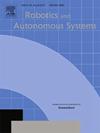基于分数阶Unscented卡尔曼滤波和DCSV的无人机同轴旋翼气动效应估计
IF 5.2
2区 计算机科学
Q1 AUTOMATION & CONTROL SYSTEMS
引用次数: 0
摘要
同轴旋翼,特别是在大型无人机(uav)中,由于复杂的旋翼相互作用,给气动建模和控制带来了新的挑战。同轴旋翼以其紧凑设计的效率而闻名,但它面临着旋翼下冲干扰、湍流和空气动力效率降低等问题,所有这些问题都会严重影响飞行稳定性和控制精度。传统的卡尔曼滤波器(KF)通常是解决这些问题的有效替代方案,但它们对于无人机的非线性动力学是不够的,导致采用Unscented卡尔曼滤波器(UKF)进行更精确的状态估计。然而,UKF的性能受到气动效应的非局部性质的限制。本文提出了一个两步走的方法来解决这些挑战。首先,通过结合分数阶导数、Merwe点选择技术和多时间尺度的DCSV(动态速度受限空间)准则,所提出的FUKF提高了实时预测精度。其次,为了验证FUKF观测信号的有效性,采用加权积分非线性动力学弱稀疏识别技术和贝叶斯MCMC(蒙特卡罗马尔可夫链)方法离线识别旋翼干涉和复杂气流的气动方程。结果表明,对于不同的时间尺度,经典的KF模型不能准确地预测与气动效应相关的状态,因为缺乏包含参数相互依赖的概念,这一概念将在即将到来的引理中引入。该方法提高了同轴旋翼气动效应的建模精度,是无人机气动效应估计技术的一大进步。本文章由计算机程序翻译,如有差异,请以英文原文为准。
Estimation of aerodynamic effects in coaxial rotors for UAVs using fractional Unscented Kalman Filter and DCSV
Coaxial rotors, especially in larger Unmanned Aerial Vehicles (UAVs), introduce new challenges in aerodynamic modeling and control due to complex rotor interactions. Known for their efficiency in compact designs, coaxial rotors face issues such as rotor downwash interference, turbulence, and reduced aerodynamic efficiency, all of which can severely impact flight stability and control precision. Traditional Kalman filters (KF) are often an efficient alternative to address these problems, but they are insufficient for the nonlinear dynamics of UAVs, leading to the adoption of the Unscented Kalman Filter (UKF) for more precise state estimation. However, UKF’s performance is limited by the non-local nature of aerodynamic effects. This paper proposes a two-step method to address these challenges. First, by incorporating fractional-order derivatives, the Merwe point selection technique, and the DCSV (Dynamic Confined Spaces of Velocities) criterion for multiple time scales, the proposed FUKF enhances real-time prediction accuracy. Second, to demonstrate the efficiency of the signals observed by the FUKF, a weak sparse identification technique for nonlinear dynamics with weighted integration and the Bayesian MCMC (Monte Carlo Markov Chain) method are used offline to identify aerodynamic equations, accounting for rotor-rotor interference and complex airflows. The results show that for different time scales, classical KF models fail to accurately predict the states associated with aerodynamic effects due to the lack of inclusion of parametric interdependence, a concept introduced in a forthcoming lemma. This approach improves the modeling accuracy of aerodynamic effects for coaxial rotors and represents an advancement in the performance of estimation techniques for UAVs.
求助全文
通过发布文献求助,成功后即可免费获取论文全文。
去求助
来源期刊

Robotics and Autonomous Systems
工程技术-机器人学
CiteScore
9.00
自引率
7.00%
发文量
164
审稿时长
4.5 months
期刊介绍:
Robotics and Autonomous Systems will carry articles describing fundamental developments in the field of robotics, with special emphasis on autonomous systems. An important goal of this journal is to extend the state of the art in both symbolic and sensory based robot control and learning in the context of autonomous systems.
Robotics and Autonomous Systems will carry articles on the theoretical, computational and experimental aspects of autonomous systems, or modules of such systems.
 求助内容:
求助内容: 应助结果提醒方式:
应助结果提醒方式:


